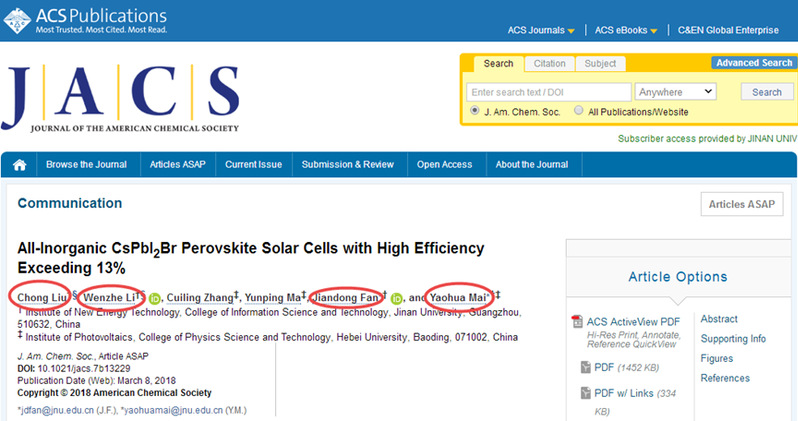- ABOUT JNU
- ADMISSION
-
ACADEMICS
- Schools and Colleges
-
Departments and Programs
- Arts College of
- Chinese Language and Culture College of
- Economics College of
- Electrical and Information Engineering College of
- Foreign Studies College of
- Information Science and Technology College of
- Environment School of
- Humanities School of
- International Business School
- International Studies School of
- Journalism and Communication College of
- Law School
- Liberal Arts College of
- Life Science and Technology College of
- Management School of
- Marxism School of
- Medicine School of
- Pharmacy College of
- Physical Education School of
- Science and Engineering College of
- Shenzhen Tourism College
- Research Institute
- Research Center
- Programs in English
- Majors
- Study Abroad
- Online Learning
- RESEARCH
- CAMPUS LIFE
- JOIN US
Headline News
JNU Publishes Research Paper in Material and Chemical Journal
Time: March. 19th, 2018
Source: College of Information Science and Technology
Publisher: JNU News Center
Prof. Mai Yaohua in Institute of New Energy Technology in JNU's, College of Information Science and Technology published a research paper titled All-Inorganic CsPbI2Br Perovskite Solar Cells with High Efficiency Exceeding 13% in the Journal of the American Chemical Society on March 8.
American Chemical Society, an authoritative journal on materials science and chemical science with an impact factor of 13.858. Mai and Prof. Fan Jiandong are the project leaders. The co-authors are doctoral candidate Liu Chong and associate researcher Li Wenzhe.

He and his team members found that the thermal instability problem of organic-inorganic perovskite solar cells (PSCs) is obstructing the industrialization process, while function layers in all-inorganic PSCs can provide thermal stability to industry. Therefore, stable and efficient all-inorganic PSCs provide a promising solution to tackle the thermal instability problem of organic-inorganic PSCs.
In the study, Mai's team developed a two-step temperature-control approach to prepare a compact and uniform CsPbI2Br thin film with high iodine content. Subsequently, we innovatively designed an all-inorganic CsPbI2Br solar cell by means of employing the ZnO@C60 bilayer as the ETL. The ZnO@C60 bilayer ETL was demonstrated to be capable of effectively enhancing charge extraction, reducing leakage loss and trap-state density. The PCE of such all-inorganic PSCs was demonstrated to be 13.3%, and the SPO could remain stable at ∼12% for 1000 s at applied forward bias. Importantly, the long-term thermal stability of the all-inorganic PSCs exhibited great improvement in comparison to the organic-species-containing PSCs. The present work helps to tackle the intractable issue regarding the thermal instability of perovskite devices and is a step forward toward realizing highly efficient and stable perovskite solar cells.
Their research is supported and funded by the National Natural Science Foundation of China (General Program, No.51672111), the Guangdong Construction Project of High-level Universities and the JNU Youth Fund of Innovation and Research Fund (No. 21617341).
Link to paper:
https://pubs.acs.org/doi/10.1021/jacs.7b13229
J. Am. Chem. Soc., 2018, DOI: 10.1021/jacs.7b13229
NEWS
- About the University
- Quick Links
Copyright © 2016 Jinan University. All Rights Reserved.




